METAL AIR WATER SYRINGE TIPS
Infection control and sanitation are critical concerns for every dental surgery. However, an often-overlooked item in this context is the air water syringe tip. To prevent cross-contamination, specific protocols are essential, and air/water syringe tips are no exception.
The air water syringe tip is the item used to spray air and water in a patient's mouth during a dental treatment. However, due to its simplicity, dentists, orthodontists, and hygienists often overlook the cross-contamination ramifications that can occur from not properly sterilizing their metal tips. It's worth noting that these professionals have been using metal tips for over 40 years. Despite the many advances in scientific technology designed to enhance patient safety during this time, these same metal air water syringe tips remain a standard item in dental practices today. Unfortunately, the cleaning methods currently being administered have been proven to be ineffective. In a very alarming 2013 study, it was discovered that 10% of metal air water tips tested contained active live bacteria.
This is a serious health concern, and it is crucial for every dentist, orthodontist, and hygienist to fully comprehend the process by which this occurs.
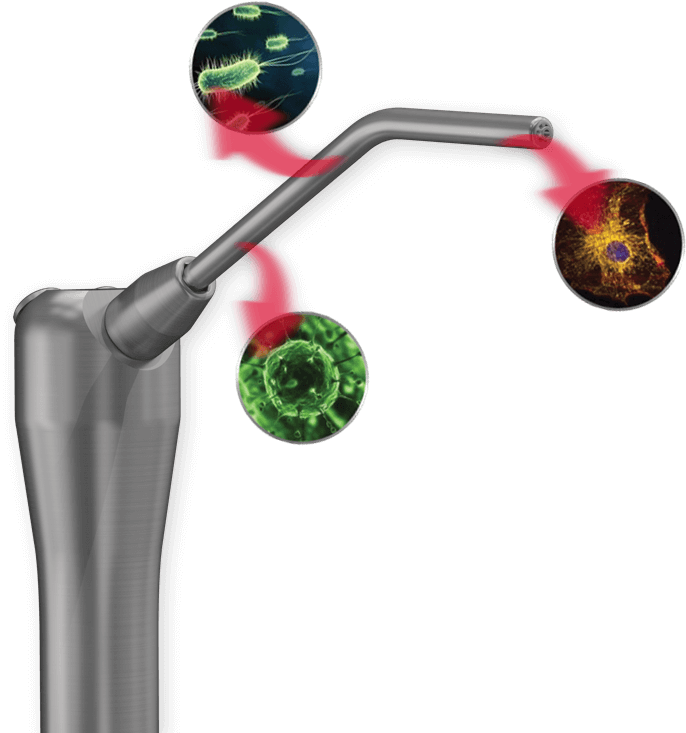
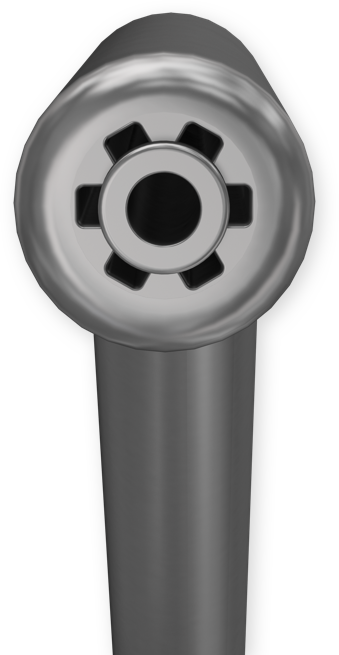
THE BIRTH OF THE METAL AIR WATER SYRINGE TIPS
Metal tips are born clean and new with smooth channels inside, however, this pristine internal environment changes.
The act of sterilizing is very hostile and exposes the tip to high temperatures and disinfectants, which alter the tip by causing warping, corrosion, and other changes to the materials used to manufacture these tips. Metal air water syringe tips that have been re-processed many times often show visible signs of deterioration including discoloration and distortion.
This corrosive process creates a different environment inside the tip making it vulnerable to the collection of debris. An older tip and its micro-lumens can have pits, fissures, and other defects where bioburden is deposited.
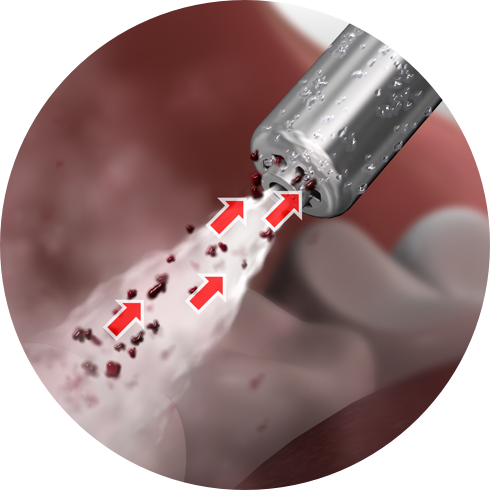
REFLUX EFFECT
Also known as aspiration or “suck-back”.
Bioburden enters metal tips in several ways. It is important to remember that blood and other potentially infectious bodily fluids can be aerosolized when metal air water syringe tips are used to treat patients (hence the common use of face shields and barrier films today). Negative water pressure is generated in most air water syringes when the buttons are released to close valves inside the syringe. The physics of this action cause suck-back (reflux) into the metal tips.
A quarter inch of blood, saliva, and tissue gets sucked into metal air water syringe tip.
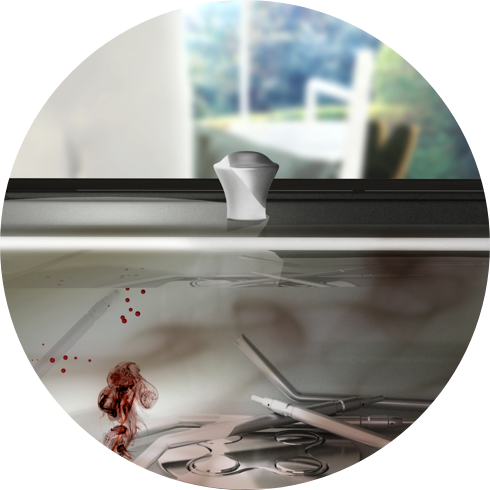
ULTRASONIC EFFECT
Metal tips are then placed into the ultrasonic solution. The ultrasonic fluid is not cleaned as often as it should, sometimes only once or twice a day!
A common practice in the sterilization process is to pre-clean instruments by placing them inside an ultrasonic bath before autoclaving. The disgusting fluid inside the ultrasonic machine is probably the most noxious area in a dental clinic. The ultrasonic is full of blood, saliva, bacteria, and other bioburden from all the patients that have had a treatment that day. This device is good at cleaning instruments on the outside; however, at the same time it introduces the contaminated fluid into the micro-lumens of metal air water syringe tips.
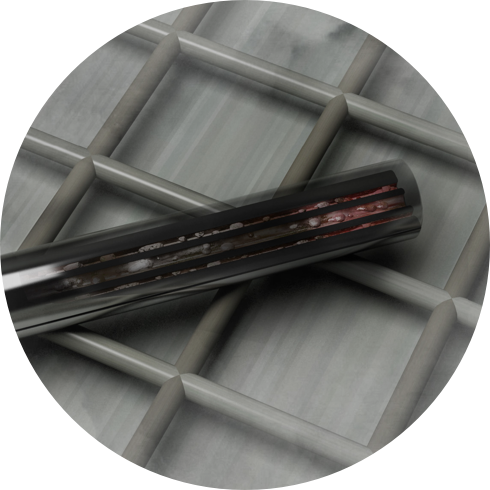
AUTOCLAVE EFFECT
After metal tips have been introduced with “suck-back” materials (blood, saliva, tissue), and after it is introduced to more biofilm and bacteria from other patients in the ultrasonic fluid, metal air water syringe tips are then placed inside an autoclave.
The standard autoclave uses heat and steam to sterilize the items placed inside. The problem is that the inside of metal tips are not anodized. What this means is that the inside of the metal tip corrodes each time it is put in the autoclave. As the corrosion continues, fissures begin to develop inside metal tips. These fissures become pockets that collect biofilm, blood, tissue and other hazardous debris.
This collected debris begins to clog the tip. When metal tips clog, the steam cannot penetrate all the way through these micro-lumens, causing a section of metal air water syringe tips to not get sterilized.

UNLUCKY PATIENT
After this process has been completed, an unlucky patient then gets treated with the ineffectively sterilized metal tip.
There have even been cases where debris inside metal tips break off and gets shot into the patients’ mouth. Does that sound appealing to you? The sad thing is the average dentist, orthodontist, and hygienist know this, yet nothing is done to improve their infection control protocols and switch to disposable air water syringe tips.
Metal tips are a difficult instrument to clean on the inside. The tip uses micro-lumens to deliver air, water, or air/water spray. The diameter of the micro-lumens is smaller than some hypodermic needles making them impossible to access. Dentists, orthodontists, and hygienists will notice that the performance characteristics of metal tips degrade over time. The spray is visibly affected causing lower pressure, misdirected spray, and moisture problems while trying to deliver dry air during certain procedures.

NEW AIR WATER SYRINGE TIPS VS. OLD AIR WATER SYRINGE TIPS
METAL AIR WATER SYRINGE TIPS
Metal tips begin to show signs of degradation after their very first use. As we discussed in the previous section of this page, metal tips are impossible to clean.
Normal wear and tear accompanied by corrosion makes these tips very dangerous and we want to show you exactly what happens. We will begin by showing you the outside of metal air water syringe tips followed by what the inside of used metal air water syringe tips really look like. In order to show you these pictures we took a cross-section of a brand new metal tip and a used metal air water syringe tip (consistently used for a 2 month period in a standard dental office). After visual inspection, you will see proof that these tips undergo rapid change after consistent use.
Remember, most dental offices use metal air water syringe tips for years before throwing them away due to clogging issues.

OUTSIDE
NEW AIR WATER SYRINGE TIPS
As you can see, new metal air water syringe tips begin with a very clean appearance. The outside has a
onsistent color throughout, and you can also observe clean surfaces with no fissures or degradation.

OUTSIDE
OLD AIR WATER SYRINGE TIPS
On the other hand, the used metal tip already exhibits significant signs of wear
and tear. Parts of the metal have already chipped, and discoloration has already started to appear.

INSIDE
NEW AIR WATER SYRINGE TIPS
As you can see, new metal air water syringe tips don't appear particularly clean from the start. The surfaces are
smooth, but they still lack a clean appearance. If a patient could see this, they would likely request the use of another
tip used for their procedure.

INSIDE
OLD AIR WATER SYRINGE TIPS
Used metal air water syringe tips appear highly soiled. You can observe a substantial amount of baked-on debris and corrosion. The baked-on debris is so thick that it obscures the surfaces of the metal air water syringe tip from visual inspection.
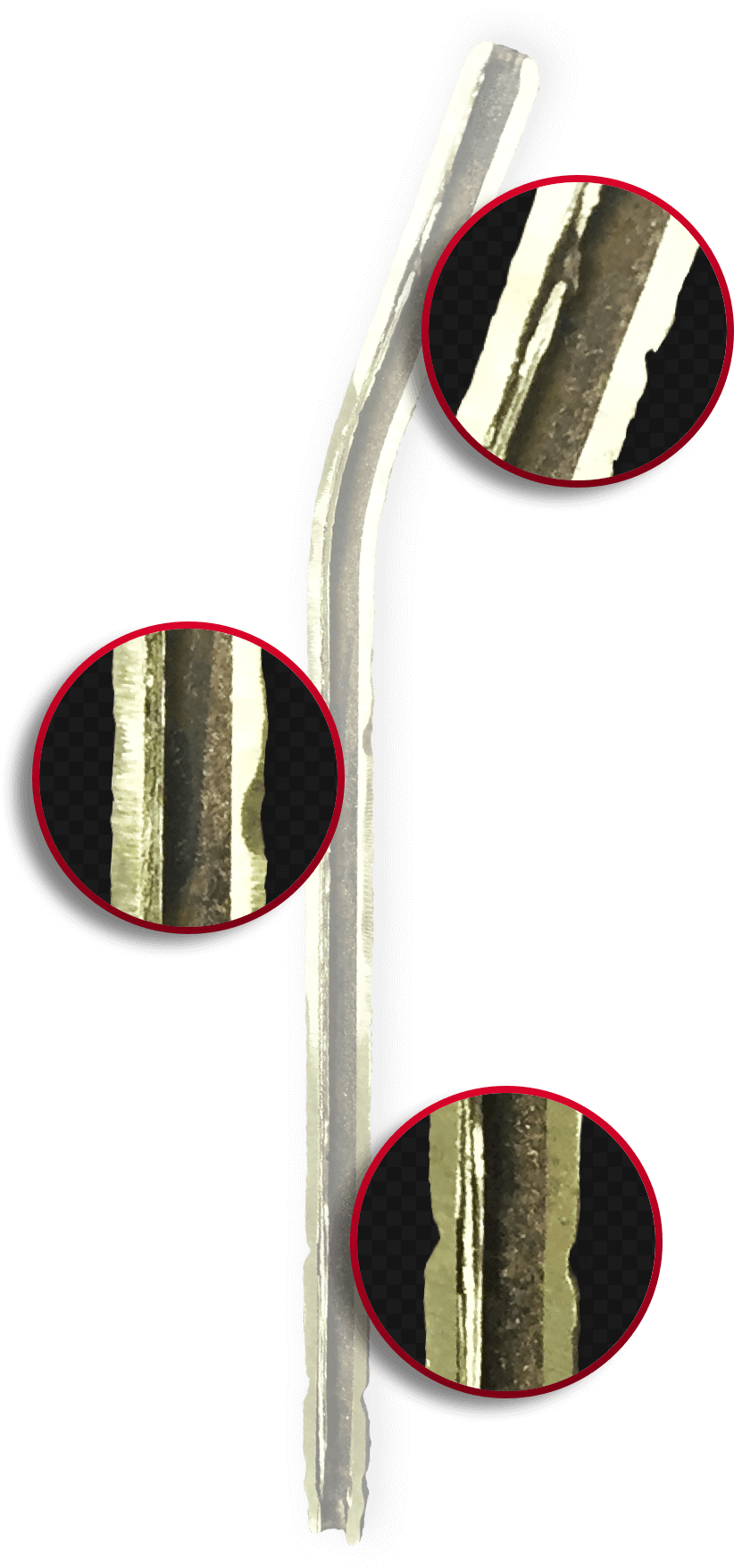
RESULTS
As you can see, used metal air water syringe tips are full of baked on debris. What once was a smooth clean surface is now full of bioburden.
The debris you observe baked into this tip all originates from the sterilization process. The reflux effect draws 1/4 inch of aerosolized blood, saliva, and debris from a patient back into the tip. The ultrasonic fluid then fills the micro-lumens of the metal air water syringe tip with contaminated bacteria. Finally, the autoclave bakes all that bacteria, blood, saliva, and tissue into the tip. You can see the end result of this process in these photos.
The metal air water syringe tip we used for this comparison was in use for only two months. Consider what it would look like after 6 months, a year, or 5 years. Dentists, orthodontists, and hygienists tend to use their tips until they are completely clogged with this bioburden. Does the used metal air water syringe tip appear to demonstrate the effectiveness of the sterilization process?
Would you prefer someone to use this tip on you or your family? We didn't think so.
SCIENTIFIC STUDIES HAVE PROVEN
THERE IS NO EFFECTIVE WAY TO STERILIZE
METAL AIR WATER SYRINGE TIPS
Scientific studies conducted by multiple groups have demonstrated that even when dental offices subject metal air water syringe tips to multiple sterilization cycles (standard dental offices typically subject them to only one cycle), the tests conducted on the tips showed that 10% of them still contained live active bacteria.
Now, 1% would suffice to deem the sterilization cycle ineffective. However, 10% is a shocking figure for any type of device used in treatments where blood, saliva, and tissue are involved. Over 20 years ago, after discovering thatmetal air water syringe tips could not be properly sterilized, dental professionals created disposable (single-use) air water syringe tips as a safer alternative. The creation of single-use tips was intended to eliminate the use of metal air water syringe tips by dentists, orthodontists, and hygienists. However, this has still not become the standard practice.
Disposable air water syringe tips are single-use tips that would be used as a replacement product for metal air water syringe tips. The purpose of disposable air water syringe tips was to eliminate cross-contamination and to ensure one tip was used on one patient. Once a disposable tip is used, it is then thrown away and a new tip would be used on the next patient.
Once again, the advancement in scientific technology helped solve another safety hazard. WRONG! Dentists, orthodontists, and hygienists from around the world are still using metal air water syringe tips in record numbers.
To view recent studies, please click on any of the links below.
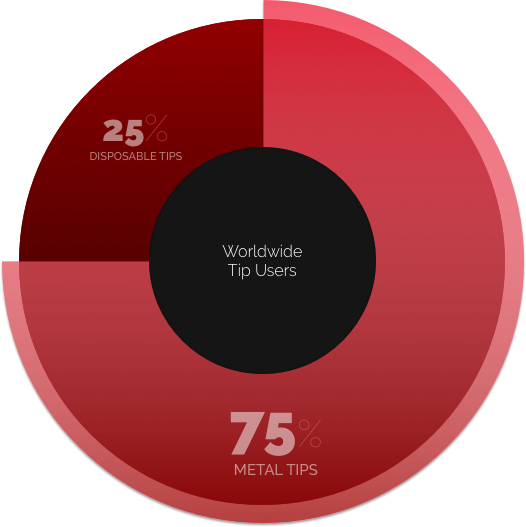
DISTORTED RATIONALE
Over 75% of dentists, orthodontists, and hygienists from around the world still use metal air water syringe tips. Even though a dentist, orthodontist, and hygienist have learned through scientific journals and studies that this item could be a hazard to patient safety, they continue to use them.
For over 20 years, dentists, orthodontists, and hygienists have turned a blind eye to using disposable air water syringe tips for reasons that would shock you. If a dentist, orthodontist, and hygienist is morally turning their back to doing something that would ensure their patients would receive a safe treatment, they must have a good reason not to… right?
Here are common excuses a dentist, orthodontist, and hygienist fall back on when asked about their continued use of metal air water syringe tips.
„Disposable tips are too expensive. I save money using metal air water syringe tips.“
„I’ve always used metal air water syringe tips. Why change now?“
„I am all about the environment. Disposable tips create a lot of unnecessary waste.”
„I have my staff clean the tips using ortho wire. I then purge the air and water lines and ensure everything is out of the tip.“
„We only use disposable air water tips on family, friends, and high-risk patients.“
„I haven’t killed anyone yet!“
Yes, Dentists, Orthodontists, and Hygienists Have Actually Said This.
Lets breakdown each air water syringe tips excuse.
Each excuse warrants some fears for the rationale a dentist, orthodontist, and hygienist is taking when deciding to NOT purchase a product that would ensure patients receive a safe dental treatment.
IT'S TOO EXPENSIVE
Some dentists, orthodontists, and hygienists believe they are saving money by re-processing tips. This may seem true at first, but when you take a closer look it is not a simple case of buy them once and you’ll decrease your overhead.
When confronted, a hygienist will admit that they replace tips much more frequently than you might think. Furthermore, metal tips end up in the trash, sink, drain, and ultimately, all of them will require replacement due to clogging. Consequently, a clogged tip affects dentistry negatively, leading to poor outcomes, as well as obvious sanitary concerns. Additionally, the cost of replacing metal tips can vary from $5 to well over $500, depending on the air water syringe type. Therefore, the primary consideration is that patient safety outweighs any potential savings.
If patients understood what could be lurking inside metal tips, there's little doubt that they would willingly pay the extra $0.25 for a single-use tip. However, most patients are unaware, and some dentists, orthodontists, and hygienists only have a vague awareness of what occurs inside the tip. Would a dentist, orthodontist, or hygienist present a visibly dirty dental instrument to the patient before beginning treatment? No, they would not, as the majority of patients would not accept it.
Remember, we're discussing what can't be seen inside metal air water syringe tips. In some cases, metal tips have remained attached to the delivery system for 10 years or more without ever undergoing autoclaving.
„Disposable air water syringe tips are too expensive. I save money using metal tips.”

WHY CHANGE NOW?
Usually this is a dentist, orthodontist, or hygienist that is stuck in their old ways. A few questions supplied will always shed some light on their misconceptions.
Back in the day, was it mandatory to wear gloves? Was it mandatory to wear a mask? No, these items were not mandatory, but as science and technology improved we learned that personal protective equipment was necessary to protect staff and patients from cross-contamination. The same goes for metal air water syringe tips.
New scientific studies have proven metal air water syringe tips are not safe, yet dentists, orthodontists, and hygienists continue to use them. As science and technologies improve, so do biofilms and viruses. New anti-biotic resistant viruses and biofilms mean we too need to create new ways of protecting ourselves. If metal air water syringe tips have been proven to have ineffective sterilization processes, doesn’t it only seem right to upgrade to a safer solution?
We find it hard for a dentist, orthodontist, and hygienist to sustain their argument when proven science shows they are wrong.
„I’ve always used metal air water syringe tips. Why change now?”

I CARE ABOUT THE ENVIRONMENT
The market for green products is still in it's infancy. Some dental offices claim they care about the environment, but when it comes to paying extra to get these products, all of a sudden their environmental stance seems to deteriorate.
Dentists, orthodontists, and hygienists claim they do not want to use disposable air water syringe tips because they have to throw away the tips after every patient. This in turn leads to an excess amount of waste that they feel is bad for the environment.
A dentist, orthodontist, and hygienist's number one priority should be the safety of their patient. Worrying about the environment as the forefront of their argument when they should be doing everything they can to protect their patients is a lapse in priorities. But at the same time, there are disposable air water syringe tips that are made from 100% compostable materials. These disposable air water syringe tips were created to help protect the environment while also protecting their patients.
As you can see, there are options for a dentist, orthodontist, and hygienist that are available, but again, it comes down to price. Currently a dentist, orthodontist, and hygienist will say they are all about “green” products until they see the price and fall back to their old ways. So again, there are options available for these dentists, orthodontists, and hygienist but they still choose to save a couple dollars over protecting their patients.
„I am all about the environment. Disposable air water syringe tips create a lot of unnecessary waste.”

I USE ORTHO WIRE
This statement is usually said when they have no logical argument. An ortho wire is a very thin wire that some dentists and orthodontists say they have their staff use to clean a metal tip.
First, consider how many dentists or orthodontists allow their hygienists to spend hours physically scraping a wire through each micro-lumen of a metal air water syringe tip. Depending on the metal air water syringe tip, there could be 4-8 lumens to clean, all of which are smaller than a hypodermic needle. Imagine a hygienist spending valuable time after each patient sitting there, scraping through a metal air water syringe tip. Do you think an office would follow these practices after every patient? Also, everyone knows that if you can't see it, you can't clean it.
For arguments sake, let’s assume metal tips have been adequately sterilized. There is a difference between sterile and sanitary.The accumulated cooked debris that has collected inside metal tips can most definitely be dislodged into the mouth of the next patient.The efficacy of a sterilization cycle depends on many variables, including the condensation of vapors on the interior walls of the syringe micro-lumens. Vapors must first penetrate a barrier (pouch or wrap) and then enter the metal tip through tiny holes. To achieve proper sterilization, the vapor must condense on the walls of the micro-lumens for a period of time. The problem is that over time, the once-smooth surface inside metal tips becomes compromised with additional surface areas that are difficult to reach due to corrosion and debris deposits.
„I have my staff clean metal air water syringe tips using ortho wire. I then purge the air and water lines and ensure everything is out of the tip.”

FRIENDS AND FAMILY ONLY
This argument is fundamentally wrong. When a dentist, orthodontist, or hygienist makes this statement, they are proving their belief that disposables are a safer alternative.
Many offices stock only a limited supply of disposable air water syringe tips for specific purposes. These purposes include treating friends, family, and high-risk patients. The rest of their patients receive treatment with metal air water syringe tips. How does this situation make you feel? If they are using these tips on loved ones and high-risk patients, why would they not choose to follow these same safety practices with you and your family? In their minds, they have acknowledged that single-use air water syringe tips offer a higher level of safety; however, in practice, they are compromising your safety.
These actions also violate Universal Precautions. Universal Precautions, as defined by the CDC and OSHA, essentially dictate that all patients should be treated with the assumption that they are infected. The presumed infection could be as mild as the flu virus or something much more serious. In fact, some of you reading this right now might be infected with something and not even know it. Some people can be asymptomatic, so they would have no reason to believe they are sick. There are other infected individuals who know they are carriers but do not disclose their condition to healthcare providers.
On your next visit, please ask your dentist, orthodontist, or hygienist how they defines whose life is valuable enough for disposable air water syringe tips.
„We only use disposable air water syringe tips on family, friends, and high-risk patients.”

I HAVEN’T KILLED ANYONE YET
You would be surprised at the frequency in which this comment is made. Even saying this as a joke is not funny.
Infection control is a serious matter and a dentist, orthodontist, or hygienist that holds this opinion is not likely to be looking out for your best interest. If they hold this opinion of air water syringe tips, what other items do they also overlook as being a “non-issue”? For these types of dentists, orthodontists, and hygienists there are no studies, examples, or technologies that will sway them from their abrasive stance on infection control.
There have been many recent news stories that say the opposite to this argument. Patients are getting sick daily from dentists, orthodontists, and hygienists who do not follow safety protocols. The sad situation is that unless a disgruntled employee or patient raises concern, these stories are never brought to light. With the lack of mandated health inspections, a dentist, orthodontist, and hygienist are left on their own to determine their own safety protocols. Until dental offices are regularly inspected, there is no way to determine how safe a dental office really is.
If you visit a dentist, orthodontist, or hygienist who uses this argument...
RUN!
„I haven’t killed anyone yet.”

Before you start your treatment, request that a disposable air water tip is used for your treatment.
WHAT DO LEADING HEALTH
AUTHORITIES SAY?
Health authorities from around the world set many recommendations for sterilization processes, but when an item is difficult to clean, like air water syringe tips, single-use products should be used.

„Considerations in selecting cleaning methods and equipment include:
1. Efficacy of the method, process, and equipment;
2. Compatibility with items to be cleaned;
3. Occupational health and exposure risk.“
Centers for Disease Control and Prevention
DeKalb County, United States

„The danger of transmission of potentially pathogenic bacteria through the use of hygienically inadequate or non-maintained additional devices is often underestimated in a dental practice.
The hygienic side of maintenance is impeded when cleaning and sterilization are difficult to be carried out due to material and construction related issues.“
Robert Koch-Institut
Berlin, Germany

HTM 01-05: Where instruments are difficult to clean, consideration should be given to replacing them into single-use instruments where possible.
Department of Health
London, England

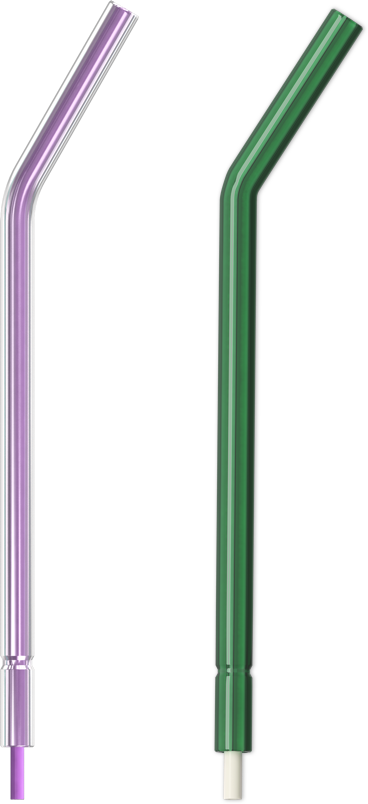
IT'S TIME TO OPEN YOUR EYES
The information and excuses you have just read about metal air water syringe tips should open your eyes when visiting a dental office. Just because the office looks clean, does not mean you cannot get sick or contract a deadly disease.
Comprehensive studies have indisputably proven that metal tips pose safety risks. Despite the compelling evidence, dental professionals, including dentists, orthodontists, and hygienists, have resisted transitioning from metal tips to disposable alternatives for over two decades, as previously discussed. This raises an ethical question: at what point does it become a moral obligation for dental professionals? Furthermore, if a dentist or orthodontist consciously conceals safety concerns from their patients before treatment, they not only betray trust but also violate the principles of informed consent and their healthcare oath to prioritize safe dental care.
Patients must take a proactive approach, asking questions and observing during dental visits to ensure their safety and that of their families. Knowledge plays a vital role, but it's only part of the effort to ensure safety during treatments by dentists, orthodontists, or hygienists with inadequate infection control practices. Every patient deserves safe dental care, highlighting the need to raise public awareness about infection control standards. Consequently, single-use tips should become a requirement, not a choice, given the numerous options available to dentists, orthodontists, and hygienists. It's time to cease prioritizing cost savings over patient safety.
Dentistry’s Dirty Secret strives to educate the public to ensure safer dental treatments. Consumer advocacy along with aggressive education of dental professionals will help drive the change needed to ensure the highest level of infection control.


